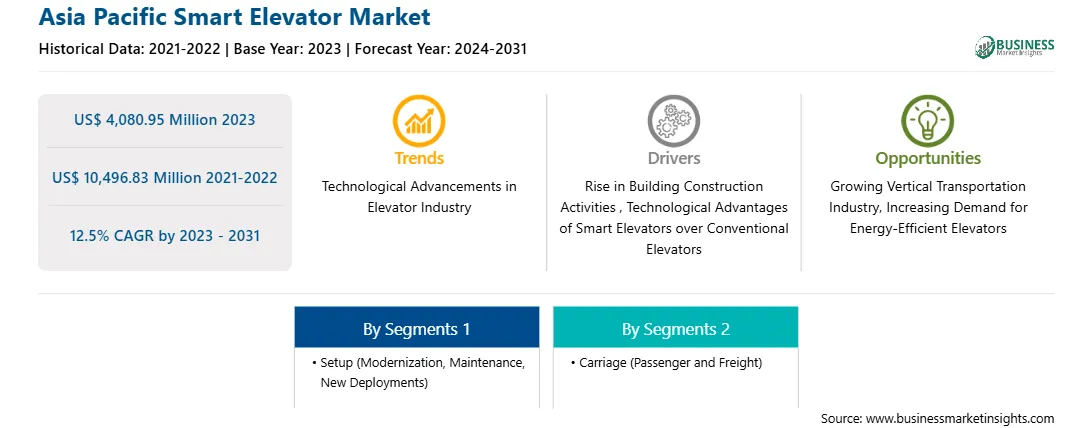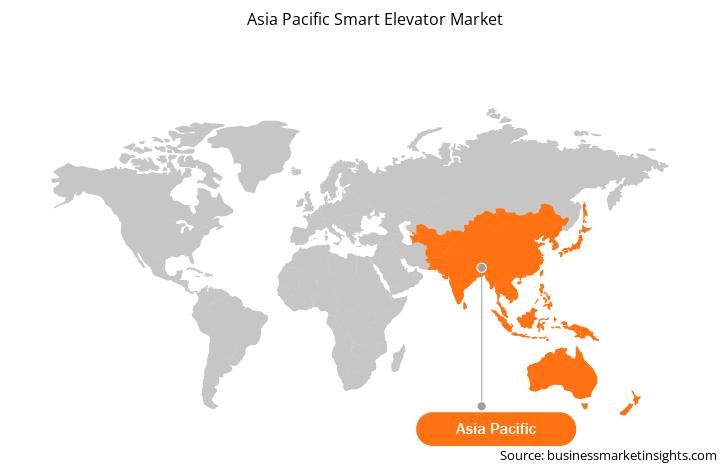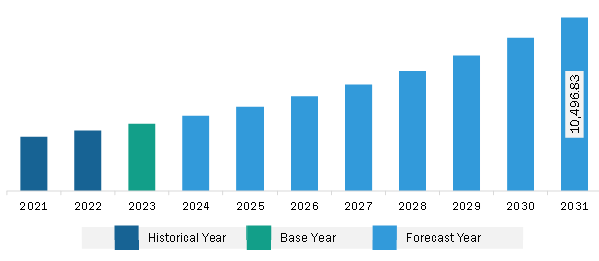The Asia Pacific smart elevator market was valued at US$ 4,080.95 million in 2023 and is expected to reach US$ 10,496.83 million by 2031; it is estimated to register at a CAGR of 12.5% from 2023 to 2031.
Basic computing power of conventional elevators cannot reduce users' waiting time. Furthermore, they are not energy efficient compared to modern elevators and do not include real-time monitoring of the elevator system. However, smart elevators are technically advanced and have various functions that contribute to their rising preference by building contractors. The usage of autonomous systems in these elevators aids in optimizing elevator actions, which, in turn, helps lessen wait time, eventually leading to more effective passenger transportation during busy hours.
Features of smart elevators such as touch screen interface, voice commands, gesture control, and mobile app controllability make them more user-friendly and enhance the comfort of passengers. Smart elevators send operational data to the cloud in real time, where certified employees can access it anytime and facilitate the timely resolution of any problem. In contrast to traditional elevators, smart elevators use progressive security measures such as facial recognition, biometrics, and other technologies to avoid unauthorized access. Furthermore, these elevators integrate sensors and other systems that continually monitor the irregular behavior of elevators, which includes excessive vibration, electrical faults, and others.
Further, customers demand innovative and more cutting-edge features from elevator systems as a result of the continuously changing technological landscape. Energy efficiency, space saving, time efficiency, long lasting, affordability, low maintenance, and safety are all benefits for modern elevators. Owing to all the benefits mentioned above, the demand for smart elevators over conventional elevators is increasing.
The market in Asia Pacific is expected to grow at the fastest CAGR during the forecast period. This growth may be attributed to the growing urbanization, supportive government initiatives, and increasing investment in infrastructural projects. For instance, in March 2021, the government of China approved China's 14th Five-Year Plan (FYP) (2021-2025), the grand strategic blueprint for the next half-decade, and longer-term goals for 2035. The government anticipated to achieve China's urbanization rate round 65% of the population by 2025 and 75% that of an advanced economy by 2035. As more individuals move from rural to urban areas, the focus is more on investment in building infrastructure.
According to The Insight Partner analysis, ~60% of the world's population lives in Asia Pacific, with China and India being the most highly populated countries. More than 2 billion people live in urban areas. This surges the demand for new buildings as well as renovations of older buildings to high-rise residential towers. Also, several cities across the region are tech hubs, which increases the number of companies expanding to the region, leading to new commercial buildings and the reconstruction of older buildings into larger space areas. Owing to these reasons, the number of people and employees using the elevators in residential and commercial buildings is highly increasing, leading to the modernization of the existing elevators into technologically better, safer, larger, and speedier ones. Therefore, the demand for smart elevators is expected to increase in Asia Pacific during the forecast period.
Strategic insights for the Asia Pacific Smart Elevator provides data-driven analysis of the industry landscape, including current trends, key players, and regional nuances. These insights offer actionable recommendations, enabling readers to differentiate themselves from competitors by identifying untapped segments or developing unique value propositions. Leveraging data analytics, these insights help industry players anticipate the market shifts, whether investors, manufacturers, or other stakeholders. A future-oriented perspective is essential, helping stakeholders anticipate market shifts and position themselves for long-term success in this dynamic region. Ultimately, effective strategic insights empower readers to make informed decisions that drive profitability and achieve their business objectives within the market.

| Report Attribute | Details |
|---|---|
| Market size in 2023 | US$ 4,080.95 Million |
| Market Size by 2031 | US$ 10,496.83 Million |
| Global CAGR (2023 - 2031) | 12.5% |
| Historical Data | 2021-2022 |
| Forecast period | 2024-2031 |
| Segments Covered |
By Setup
|
| Regions and Countries Covered | Asia-Pacific
|
| Market leaders and key company profiles |
The geographic scope of the Asia Pacific Smart Elevator refers to the specific areas in which a business operates and competes. Understanding local distinctions, such as diverse consumer preferences (e.g., demand for specific plug types or battery backup durations), varying economic conditions, and regulatory environments, is crucial for tailoring strategies to specific markets. Businesses can expand their reach by identifying underserved areas or adapting their offerings to meet local demands. A clear market focus allows for more effective resource allocation, targeted marketing campaigns, and better positioning against local competitors, ultimately driving growth in those targeted areas.

Strategic insights for the Asia Pacific Smart Elevator provides data-driven analysis of the industry landscape, including current trends, key players, and regional nuances. These insights offer actionable recommendations, enabling readers to differentiate themselves from competitors by identifying untapped segments or developing unique value propositions. Leveraging data analytics, these insights help industry players anticipate the market shifts, whether investors, manufacturers, or other stakeholders. A future-oriented perspective is essential, helping stakeholders anticipate market shifts and position themselves for long-term success in this dynamic region. Ultimately, effective strategic insights empower readers to make informed decisions that drive profitability and achieve their business objectives within the market. The geographic scope of the Asia Pacific Smart Elevator refers to the specific areas in which a business operates and competes. Understanding local distinctions, such as diverse consumer preferences (e.g., demand for specific plug types or battery backup durations), varying economic conditions, and regulatory environments, is crucial for tailoring strategies to specific markets. Businesses can expand their reach by identifying underserved areas or adapting their offerings to meet local demands. A clear market focus allows for more effective resource allocation, targeted marketing campaigns, and better positioning against local competitors, ultimately driving growth in those targeted areas.
Asia Pacific Smart Elevator Strategic Insights

Asia Pacific Smart Elevator Report Scope
Report Attribute
Details
Market size in 2023
US$ 4,080.95 Million
Market Size by 2031
US$ 10,496.83 Million
Global CAGR (2023 - 2031)
12.5%
Historical Data
2021-2022
Forecast period
2024-2031
Segments Covered
By Setup
By Carriage
Regions and Countries Covered
Asia-Pacific
Market leaders and key company profiles
Asia Pacific Smart Elevator Regional Insights

The Asia Pacific smart elevator market is segmented based on carriage, setup, application, and country.
In terms of carriage, the Asia Pacific smart elevator market is bifurcated into passenger and freight. The passenger segment held a larger share in 2023.
Based on setup, the Asia Pacific smart elevator market is segmented into modernization, maintenance, and new deployments. The new deployments segment held the largest share in 2023.
By application, the Asia Pacific smart elevator market is segmented into residential, commercial, and industrial. The commercial segment held the largest share in 2023.
Based on country, the Asia Pacific smart elevator market is categorized into Australia, China, India, Japan, South Korea, and the Rest of Asia Pacific. China dominated the Asia Pacific smart elevator market in 2023.
Fujitec Co Ltd, Otis Worldwide Corp, Kone Corp, Hyundai Elevator Co Ltd, Thyssen Krupp AG, Schindler Holding AG, Mitsubishi Electric Corp, Hitachi Ltd, Toshiba Elevator and Building Systems Corporation, and Smart Plus Elevator Pvt. Ltd. are some of the leading companies operating in the Asia Pacific smart elevator market.
The Asia Pacific Smart Elevator Market is valued at US$ 4,080.95 Million in 2023, it is projected to reach US$ 10,496.83 Million by 2031.
As per our report Asia Pacific Smart Elevator Market, the market size is valued at US$ 4,080.95 Million in 2023, projecting it to reach US$ 10,496.83 Million by 2031. This translates to a CAGR of approximately 12.5% during the forecast period.
The Asia Pacific Smart Elevator Market report typically cover these key segments-
The historic period, base year, and forecast period can vary slightly depending on the specific market research report. However, for the Asia Pacific Smart Elevator Market report:
The Asia Pacific Smart Elevator Market is populated by several key players, each contributing to its growth and innovation. Some of the major players include:
The Asia Pacific Smart Elevator Market report is valuable for diverse stakeholders, including:
Essentially, anyone involved in or considering involvement in the Asia Pacific Smart Elevator Market value chain can benefit from the information contained in a comprehensive market report.